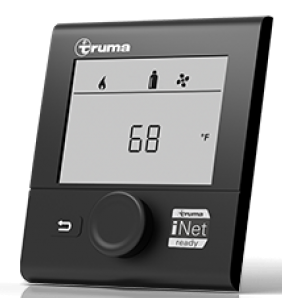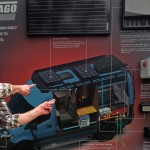This post may contain affiliate links.
Truma AquaGo water heaters have been around for quite a while now, but our Winnebago EKKO is our first RV with one. We didn’t know what we were missing! If you’re used to waiting for your water heater to “heat up”, the AquaGo is a game changer.
But over time, the calcium and other minerals in your RV’s water can collect inside the AquaGo, and you need to get rid of that gunk. It’s really pretty easy with the AquaGo, because they designed a way to do it right into the water heater. You won’t be mixing up a home-brew vinegar solution to run through your RV’s plumbing. Instead, you’ll use Truma’s de-calcification tablets.

This is the CP-Plus control panel. Image courtesy of Truma.
When it was time to run through the process on our EKKO, I did what many people probably do: surf through YouTube to find someone showing me how to do it. And I found lots of videos on the process. But there was one problem: All of these videos show the process using the single-unit AquaGo control panel… which we don’t have. If you have more than one Truma appliance in your RV, you likely have the CP-Plus control panel like we do. So I had to figure out the process with the CP-Plus. (Well, I didn’t actually figure it out all on my own, I asked Truma.) The result is this video.
There’s really only a few things you need to run through the process:
- Truma AquaGo Decalcification tablets
- Water
- Time
- Your Original AquaGo Strainer (if you changed it out for an electric antifreeze kit)
Once you have all those, you can follow along with the video. Start to finish, it will take you about 3 hours.
A Few Final Notes
Prior to running the rinse cycle, it would have been better if I had removed the aerators and strainers from faucets, and also removed the showerhead. The reason why is that if the clean cycle dislodges any sediment or debris, you don’t want to trap that inside your plumbing fixtures behind a screen or filter. I did check them afterwards, but it would have been better to do it during the process.
Also – after the rinse cycle, Truma recommends that you drain your hot water system and check the Truma filter for debris before resuming normal operation. Since I was going to sanitize my entire water system afterwards anyway, I didn’t do this specifically. I wind up draining and removing the filter a number of times during my sanitizing procedure, so trust me – I got it done. But if you’re not going to sanitize, then do be sure to drain it and check for debris one last time before getting back to normal.
And there you have it! Any comments or questions, sound off below. (But if the questions are super-technical, I may pass you off to Truma!)











James when I press clean and then start the recirc pump didn’t seem to come on an my panel in Ekko does lock or indicate it is cleaning? Any advice? Thanks
Well that’s odd. Ours definitely ran the pump and indicated it was cleaning.
I’d try it again as if nothing had happened.
If that doesn’t work, it’s probably best to call Truma directly. They’re known for their attentive service, so they should be able to get you going quickly.
I was just watching other RVers with 5th wheels cleaning out their water heaters, rinsing out all the minerals from the tank, and replacing their anodes. Is there anything that EKKO owners need to do to their hot water heaters or is that what this decalcification process is for? If so, what about any sediment left behind in the water heater?
The decalcification process pretty much takes care of that kind of maintenance for Truma AquaGo owners. Any sediment should be rinsed out during the process.
James, there’s nothing I can say that I’m sure you haven’t heard a million times. Your mods are legendary. I haven’t found anyone on YouTube who compares. I have devoured every video you release, and now have an EKKO coming in myself soon. Going through them again and, this time, taking notes.
Regarding the decalcification, would you recommend (and is there room for) adding a water softener to help prevent, or at least lessen, any calcification? (And thank you Stef, because your videos are going to be my routine when I get moved into my EKKO. I’m a bookworm who loves to read, study, learn, etc., So, I need to make sure I’m balancing that with exercise.)
I wouldn’t bother with a water softener. There’s not a ton of room, and the decalcification is super easy.
It would be bringing a $2000 solution to fix a $25 problem.
At the very end of your video, you mention taking the opportunity to sanitize your water system. I’ve researched and tried several methods, but curious, what is your go-to method and sanitizing agent?
This stuff is what I’ve used for several years now. https://amzn.to/43s4rrV
It takes a couple more rinses to get the smell and taste out afterwards. It’s technically not bleach.
“Decalcify it every so often.” That’s rather vague for a German firm like Truma. Have you seen any guidance on how often is “every so often”?
I haven’t seen an official recommendation, as I suppose it depends on your water hardness. I believe it will tell you on the CP-Plus when it’s necessary.
But as we were coming up on two years, and I hadn’t seen the warning yet, I thought it was time.
Great presentation,,,again, At 3:45 in the presentation you turned off the water heater at the outside switch. I assume that when you were running the de-cal cycle at the inside control panel that turned the water heater on again. I’m assuming that because at 8:57 you turned it off again at the outside switch. Again thanks for all the easy to follow posts
At 5:27 in the video, I do say to come back outside and turn the Truma AquaGo back on. I mention it, but I do not specifically show it.
It’s literally just flipping the switch back on, and if you don’t do it, you can’t continue the process, because the AquaGo won’t respond and go into clean mode.
Hope that clears it up!
One more question. The Truma instructions as far as I can see does not say if the propane should be on or off or it does not matter. Thanks again
I didn’t specifically ask this, but I left ours ON while running through the procedure.
If the propane is off, and the Truma tries to light, it will throw an error. And I didn’t want any errors during the procedure, so I left it on.
Your videos are always interesting and informative, and extremely helpful… especially because—after a VERY long wait—we take delivery of our new EKKO this coming Thursday. WOOHOO! Thanks for helping us make the decision.
Congratulations! You’ll love it!
Since I never hook to city water, I draw from my Pleasureway Ascent’s 20 gallon fresh tank. Truma’s “8 gallon rinse” is more like 15 gallons! I forgot to top off the tank before decalcifying this year—it finished the rinse cycle just as the main water pump started to cavitate.
Yeah, I thought it was more than 8 gallons as well.
We never hook up to city water either, so I topped off before making this video.